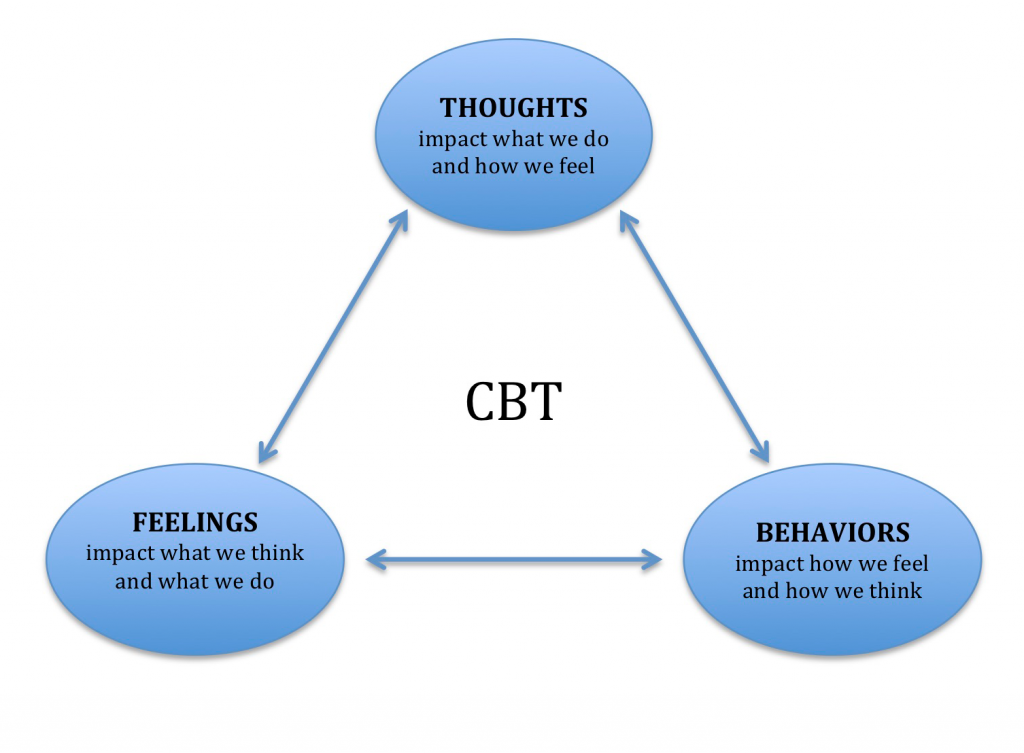Let’s be honest: the start of the school year can feel a lot less like a fresh start and a lot more like an emotional tornado wrapped in a to-do list. If your thoughts are racing, your stomach is in knots, or you’re lying awake wondering how you’re going to manage it all, you’re not alone. Back-to-school anxiety for parents is real and often not discussed.

Back-to-School Anxiety Isn’t Just for Kids – Parents Feel It Too
Back-to-school anxiety is extremely common among parents. And while it’s easy to think, “It’s just a busy season, I’ll power through,” it’s worth slowing down and paying attention to what’s going on beneath the surface.
Here’s the good news: Understanding your anxiety through a cognitive-behavioral therapy (CBT) lens can help you feel more grounded and more in control – even when life feels anything but.
1. Notice the Thought-Feeling-Behavior Cycle
CBT starts with this core idea: our thoughts affect how we feel, and how we feel affects what we do.

Here’s an example:
- Thought: “I’m already failing. Everyone else seems to have it together.”
- Feeling: Defeated, anxious, irritable
- Behavior: You procrastinate, snap at your partner or kids, or overwork trying to “catch up”
Sound familiar?
When you notice yourself feeling overwhelmed or anxious, pause and ask:
- What was I just thinking?
- Is that thought helpful or true?
- How is it affecting my mood or behavior right now?
The goal isn’t to shame yourself. It’s just to shine a light on the patterns so you can begin to shift them.
2. Challenge Catastrophic Thoughts Caused By Your Back-to-School Anxiety
Anxiety loves to jump to worst-case scenarios:
- “What if my kid has a meltdown at drop-off every day?”
- “What if I can’t keep up and everything falls apart?”
- “What if I mess this up and they struggle all year?”
These thoughts feel real – and they are loud! But they’re not always accurate.
Try asking yourself:
- “What’s the actual evidence for this thought?”
- “What’s another way to look at this?”
- “If my friend were having this thought, what would I say to them?”
CBT doesn’t ask you to be blindly optimistic. It just helps you move toward more balanced, flexible thinking – especially when anxiety is distorting the view.
3. Make a Plan (Instead of Just Worrying About One)
Worry creates the illusion of control. It feels like doing something, but often it just leaves you more mentally drained. CBT teaches us to shift from rumination to problem-solving. Here’s how:
- Identify the specific worry (i.e., “I’m anxious about chaotic mornings.”)
- Ask: Is this a real problem I can take action on?
- If yes, brainstorm 1-2 small steps (i.e., prep clothes the night before, build in a 5-minute buffer)
- If no, practice letting the worry go (i.e., with a grounding exercise, mindfulness, or self-compassion)
Pro tip: You can’t plan your way into total certainty – but you can build confidence in your ability to cope.

4. Use Behavioral Experiments to Test Your Beliefs
One common CBT strategy is the behavioral experiment. It’s basically a way of asking, “What if I tried something different and observed the result?”
For example:
- If you believe, “If I don’t control every detail, everything will fall apart,” try letting go of one small thing (like school snack perfectionism), and see what actually happens.
- Or if you think, “I have to hide my stress so I don’t upset my kids,” try being honest (“Mom’s feeling a little overwhelmed today too”) and see if it creates connection instead of chaos.
This is how we start to loosen anxiety’s grip – not just by thinking differently, but by giving ourselves evidence that different is possible.
5. Schedule Time to Recharge (Yes, Put It on the Calendar)
Your nervous system needs recovery time to stay regulated. When you’re constantly in go-mode, your stress response doesn’t get a chance to rest.
So: schedule recovery tie the same way you schedule school drop-offs or soccer practice. Put it on the calendar. Protect it. Treat it like it matters – because it does.
And no, it doesn’t have to be a full spa day. A walk. A 10-minute break with your coffee. A no-phone car ride after drop-off. Anything that gives your brain a moment to breathe.
This isn’t indulgent. It’s necessary.

Practice Self-Compassion, Not Self-Criticism, to Manage Back-to-School Anxiety
When anxiety shows up, it often brings a sidekick: self-judgment. You might think:
- “Why am I so anxious about this? Other parents are handling it fine.”
- “I should be stronger, more organized, less emotional.”
But here’s the CBT twist: Beating yourself up doesn’t make you feel less anxious. It makes you feel more anxious – and more stuck.
Try treating yourself like you’d treat a struggling friend – with kindness, not criticism. Try saying:
- “This is hard, and I’m doing my best.”
- “It’s okay to feel this way. I can handle it.”
You’ll be amazed how differently your body and mind respond when you lead with compassion.
Final Thought: You Don’t Need to Eliminate Anxiety – Just Learn to Work With It
The goal isn’t to make back-to-school anxiety disappear. (Spoiler alert: it probably won’t.)
The goal is to notice it, understand it, and respond to it differently.
With awareness, skill-building, and a little self-kindness, you can meet this season from a steadier place – even when it’s messy. Even when it’s hard.
You’ve got this. And if today you don’t feel like you do? That’s okay too. Start where you are.


